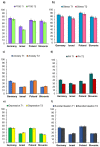Prevalence and Sociodemographic Predictors of Mental Health in a Representative Sample of Young Adults from Germany, Israel, Poland, and Slovenia: A Longitudinal Study during the COVID-19 Pandemic
- PMID: 35162364
- PMCID: PMC8835083
- DOI: 10.3390/ijerph19031334
Prevalence and Sociodemographic Predictors of Mental Health in a Representative Sample of Young Adults from Germany, Israel, Poland, and Slovenia: A Longitudinal Study during the COVID-19 Pandemic
Abstract
The aim of this cross-national longitudinal study was to evaluate the prevalence and sociodemographic predictors of mental health indicators (coronavirus-related post-traumatic stress disorder (PTSD), perceived stress, anxiety, depression, and suicidal/self-harm ideation) during the coronavirus disease-2019 (COVID-19) pandemic in a three-month period among representative samples of young adults from Germany, Israel, Poland, and Slovenia. The participants were 1724 young adults between 20 and 40 years of age (M = 30.74, SD = 5.74). The first measurement (T1) was in February 2021 and the second (T2) was in May-June 2021. The samples were representative of young adults in each country: Germany (n = 418, 24%), Israel (n = 428, 25%), Poland (n = 446, 26%), and Slovenia (n = 431, 25%). Women constituted 54% (n = 935) of the total sample. The mental health indicators were coronavirus-related PTSD measured by PCL-S, perceived stress (PSS-10), anxiety (GAD-7), depression (PHQ-8), and suicidal ideation (PHQ-9). The participants completed an online questionnaire that also included a physical activity (PA) measurement and sociodemographic variables. The Pearson's χ2 independence test was used for prevalence comparisons and McNemar's χ2 was used for longitudinal changes, whereas generalized estimating equations (GEEs) were used for the predictors of change in mental health indices. Significant differences were found between countries in each mental health dimension in both T1 and T2, with moderate effect sizes for coronavirus-related PTSD and suicidal ideation. The highest rate of PTSD and depression risk was in Germany, the highest rates of stress and anxiety risk were in Poland, and there was insufficient PA in Slovenia. The anxiety, depression, and suicidal ideation rates were the lowest in Israel and Slovenia. Israeli participants reported the lowest rate of coronavirus-related PTSD among the other countries in T1 and T2. Significant decreases in coronavirus-related PTSD and stress were observed during T2 compared to T1 in the total sample. There was no change in the risk of anxiety, depression, or suicidal ideation. Being single was a predictor of changes in all mental health indices. Having children was a risk factor for coronavirus-related PTSD and high stress. Being a student was a predictor of depression and suicidal ideation. A younger age (20-29 years) predicted coronavirus-related PTSD risk, whereas female gender predicted high stress. The mental health indices improved over time or remained stable. The groups that are most prone to mental health problems were single individuals, students, and parents in young adulthood across all countries. Future intervention programs for young adults should consider these factors when prioritizing, planning, and implementing such programs.
Keywords: COVID-19; anxiety; coronavirus-related post-traumatic stress disorder; cross-national study; depression; longitudinal study; mental health; perceived stress; young adults.
Conflict of interest statement
The authors declare no conflict of interest.
Figures


References
-
- Bonsaksen T., Leung J., Schoultz M., Thygesen H., Price D., Ruffolo M., Geirdal A.Ø. Cross-National Study of Worrying, Loneliness, and Mental Health during the COVID-19 Pandemic: A Comparison between Individuals with and without Infection in the Family. Healthcare. 2021;9:903. doi: 10.3390/healthcare9070903. - DOI - PMC - PubMed
-
- Pierce M., Hope H., Ford T., Hatch S., Hotopf M., John A., Kontopantelis E., Webb R., Wessely S., McManus S., et al. Mental health before and during the COVID-19 pandemic: A longitudinal probability sample survey of the UK population. Lancet Psychiatry. 2020;7:883–892. doi: 10.1016/S2215-0366(20)30308-4. - DOI - PMC - PubMed
Publication types
MeSH terms
Grants and funding
LinkOut - more resources
Full Text Sources
Medical

